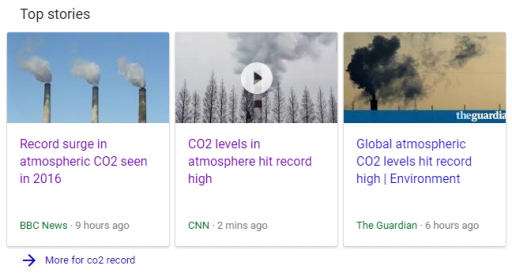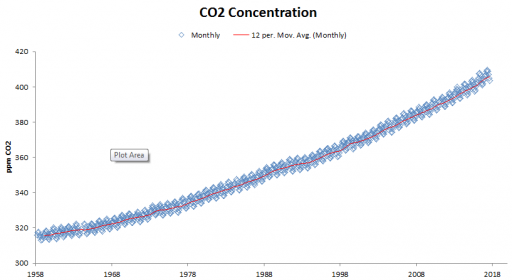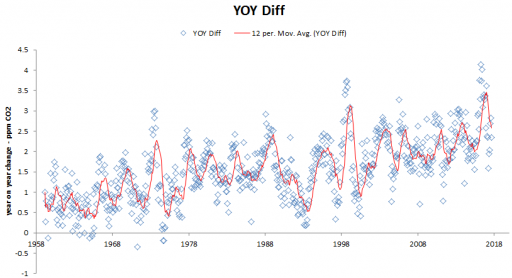The 2016 record in CO2 concentration and increment is exactly what you’d expect for a system driven by growing emissions.

Here’s the data. The CO2 concentration at Mauna Loa has increased steadily since records began in 1958. Superimposed on the trend is a seasonal oscillation, which you can remove by a moving average over a monthly window (red):

In a noiseless system driven by increasing, you’d expect every year to be a concentration record, and that’s nearly true here. Almost 99% of 12-month intervals exceed all previous records.
If you look at the year-on-year difference in monthly concentrations, you can see that not only is the concentration rising, but the rate of increase is increasing as well:

This first difference is noisier, but consistent. As a natural consequence, you’d expect a typical point to be higher than any average of the interval preceding.
In other words, a record concentration coinciding with a record increase is not unusual, dynamically or statistically. Until emissions decline significantly, news outlets might as well post a standing item to this effect.
The CO2 concentration trajectory is, incidentially, closer to parabolic than to exponential. That’s because emissions have risen more or less linearly in recent decades,
CO2 emissions, GtC/yr
CO2 concentration (roughly) integrates emissions, so if emissions = c1*time, concentration = c2*time^2 is expected. The cause for concern here is that a peak in the rate of increase has occurred at a time with flat emissions for a few years, signalling that saturation of natural sinks may be to blame. I think it’s premature to draw that conclusion, given the level of noise in the system. But sooner or later our luck will run out, so reducing emissions is as important as ever.
After emissions do peak, you’d expect CO2 difference records to become rare. However, for CO2 concentrations to stop setting records requires that emissions fall below natural uptake, which will take longer to achieve.


Some of the dynamics behind the noise:
http://journals.ametsoc.org/doi/abs/10.1175/1520-0442(2001)014%3C4113%3ATCCRTE%3E2.0.CO%3B2